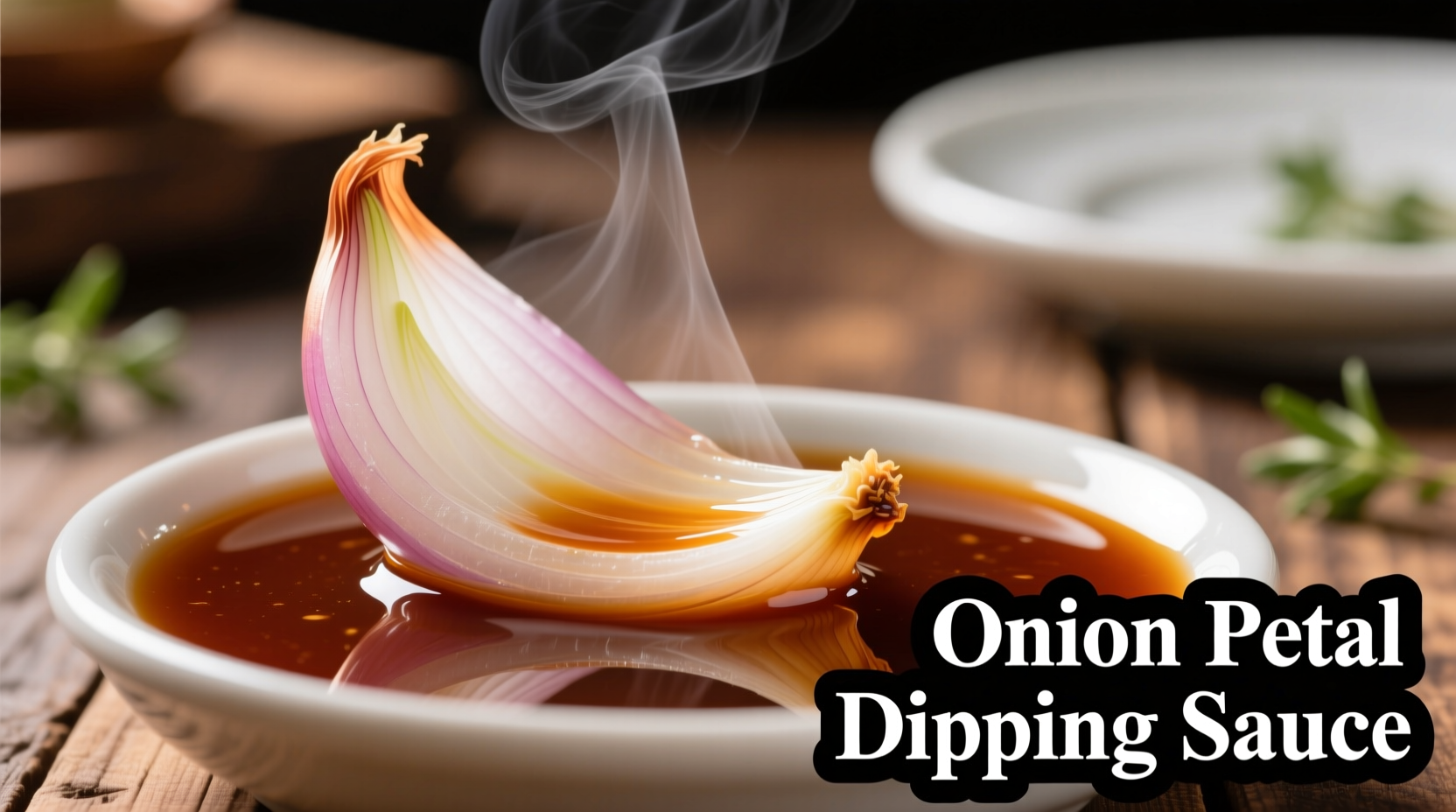What Exactly Are Onion Petals?
Onion petals refer to the individual layers of an onion that have been carefully separated to create a "blooming" effect, most famously seen in restaurant-style blooming onions. This preparation technique maximizes surface area for even frying and creates an attractive presentation. When selecting onions for petal preparation, Vidalia or Walla Walla sweet onions work best due to their larger size and milder flavor profile compared to yellow onions.
The Science Behind the Perfect Dipping Sauce
Creating an effective onion petal dipping sauce requires understanding flavor chemistry. The natural sulfur compounds in onions create a sharp, pungent taste that benefits from balancing elements:
- Fat content (from mayonnaise or sour cream) coats the tongue and reduces onion's harshness
- Acidity (lemon juice or vinegar) cuts through richness and refreshes the palate
- Aromatic compounds (garlic, herbs) complement rather than compete with onion's flavor
- Umami elements (Worcestershire sauce, paprika) deepen the overall flavor profile
| Dipping Sauce Component | Function | Optimal Amount for 2 Cups Sauce |
|---|---|---|
| Mayonnaise | Fat base for mouthfeel and flavor carrier | 1 cup |
| Sour cream | Acidity and tanginess | ¾ cup |
| Fresh herbs | Aromatic complexity | 2 tbsp chopped |
| Acid component | Palate cleanser | 1-2 tbsp |
| Umami enhancer | Flavor depth | 1 tsp |
Classic Onion Petal Dipping Sauce Recipe
This professional chef-tested recipe yields approximately 2 cups of dipping sauce, perfect for one large blooming onion:
Ingredients You'll Need
- 1 cup high-quality mayonnaise (full-fat for best texture)
- ¾ cup sour cream (not reduced fat)
- 2 tablespoons freshly minced garlic
- 2 tablespoons finely chopped fresh parsley
- 1 tablespoon fresh lemon juice
- 1 teaspoon smoked paprika
- ½ teaspoon onion powder (enhances existing flavor)
- ¼ teaspoon cayenne pepper (optional for heat)
- Salt to taste (start with ½ teaspoon)
Step-by-Step Preparation
- Chill your mixing bowl - Cold temperatures help maintain emulsion stability
- Combine mayonnaise and sour cream - Whisk until smooth with no streaks
- Add dry ingredients - Incorporate paprika, onion powder, cayenne, and salt
- Mix in fresh components - Fold in garlic and parsley to preserve freshness
- Add acid last - Stir in lemon juice to prevent premature curdling
- Rest before serving - Refrigerate for at least 30 minutes to allow flavors to meld

When This Sauce Works Best (And When It Doesn't)
Understanding context boundaries ensures optimal results with your onion petal dipping sauce:
- Ideal applications: Served with freshly fried blooming onions, as a burger spread, or as a vegetable crudité dip
- Temperature considerations: Best served chilled (40-45°F) - warm temperatures cause separation
- Timing limitations: Maximum freshness within 24 hours (after 48 hours, texture degrades significantly)
- Ingredient substitutions: Greek yogurt can replace sour cream but increases tanginess; avoid low-fat alternatives which compromise texture
Evolution of Onion-Based Dipping Sauces
Onion dipping sauces have evolved significantly over the past century:
- Early 1900s: Basic mixtures of sour cream and chopped onions served with raw vegetables
- 1950s: Introduction of mayonnaise-based versions coinciding with the popularity of ranch dressing
- 1980s: Restaurant chains popularized the "blooming onion" concept requiring specialized dipping sauces
- 2000s: Gourmet variations incorporating specialty ingredients like truffle oil and artisanal spices
- Present day: Health-conscious adaptations using Greek yogurt and plant-based alternatives while maintaining flavor integrity
Pro Tips for Sauce Success
Professional chefs recommend these techniques for perfect onion petal dipping sauce every time:
- Garlic preparation: Mince garlic finely and let it sit for 10 minutes before adding to maximize flavor compounds
- Herb selection: Flat-leaf parsley provides better texture than curly parsley; chives make an excellent alternative
- Texture control: If sauce becomes too thick, add water one teaspoon at a time rather than more dairy
- Flavor balancing: Taste after resting period and adjust acid or salt as needed - flavors change as ingredients meld
- Serving presentation: Garnish with a light dusting of paprika and fresh herb sprig for visual appeal
Common Variations to Try
Once you've mastered the classic version, experiment with these professional variations:
- Spicy Southwest: Add 1 diced chipotle pepper in adobo sauce and 1 teaspoon cumin
- Herb Garden: Increase fresh herbs to 1¼ cup total (parsley, chives, dill, tarragon)
- Lemon-Dill: Replace paprika with 2 tablespoons fresh dill and increase lemon juice to 2 tablespoons
- Smoky Bacon: Add 2 tablespoons finely minced cooked bacon and 1½ teaspoons liquid smoke
- Lighter Version: Substitute half the mayonnaise with Greek yogurt (note: increases tanginess)
Troubleshooting Guide
Fix common issues with these professional solutions:
- Sauce is too thin: Add 1-2 tablespoons additional mayonnaise and chill for 15 minutes
- Sauce is too thick: Incorporate water one teaspoon at a time until desired consistency
- Flavor is too sharp: Balance with 1 teaspoon honey or maple syrup to counter acidity
- Sauce has separated: Start with 1 tablespoon cold water and slowly whisk in broken sauce
- Not enough onion flavor: Add ¼ teaspoon onion powder (fresh onion adds unwanted moisture)
Storage and Food Safety Guidelines
Proper storage maintains both quality and safety of your dipping sauce:
- Refrigerate in airtight container for up to 3 days (USDA Food Safety and Inspection Service guidelines for egg-containing sauces)
- Do not leave at room temperature for more than 2 hours (1 hour if ambient temperature exceeds 90°F)
- Freezing is not recommended as it causes permanent texture changes
- Always use clean utensils when serving to prevent contamination
- Discard if sauce develops off-odors, mold, or significant separation that doesn't reincorporate with stirring











 浙公网安备
33010002000092号
浙公网安备
33010002000092号 浙B2-20120091-4
浙B2-20120091-4